
Station Name: BROCKLEY LANE[Source:
Nick Catford]
Brockley Lane Station Gallery 1: c1905 - February 1982 old1.jpg) A passenger train heading in the direction of Nunhead approaches Brockley Lane behind SE&CR class M2 4-4-0 No.642. This locomotive began life as LC&DR No.183 and armed with this information we know the photograph dates from after 1899, the year the SE&CR was formed out of a joint management arrangement between the LC&DR and SER. The M2 class was a William Kirtley design dating from 1884 and totaled just eight examples. The Railways Act 1921, better known as The Grouping, saw the formation of the Southern Railway on 1 January 1923 by which time only one member of class M2 remained and this was withdrawn the same month. The single headcode disc on the locomotive chimney indicated Nunhead - Greenwich (and vice versa) local services and is believed to be from the LC&DR's headcode directive of 1898 which remained in force under SE&CR auspicies until 1917, coincidentally the same year Brockley Lane station closed. This view gives an insight into the mainly, but not entirely, wooden construction of Brockley Lane's platforms. The sight of gas lighting with cast iron standards illuminating wooden platforms was not especially common and the burners appear to be of the naked flame type as opposed to incandescent mantle. The signal is to a LC&DR design, utilising a single post for both Up Home and Down Starter signal arms. On the platform, of the persons there present the gentleman with the braided cap will be the stationmaster. Typical of the time, the station appears well-adorned with enamel advertisements but unfortunately only one can be identified; that at the far end, facing the camera, being obviously for Nestles Milk. In the right background is St Peter's Church, situated on Wickham Road. Although close to the railway, the church appears to be nearer than it actually is and such tricks, done to include local landmarks, were common with old postcard views. St Peter's Church was built between 1866 and 1870, largely of sea-worn stone obtained from the coast of Kent. The church tower was to later lose its ornate finials.
Copyright photo from John Alsop collection  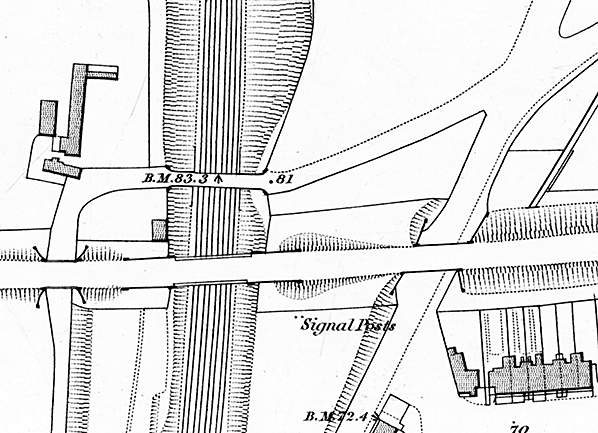
1873 1:2,500 OS map shows the likne under construction. Although the line and Brockley Lane station was open by this date the survey was made 1869 - 1871. Many of the houses shown on the 1895 map below have not yet been built.
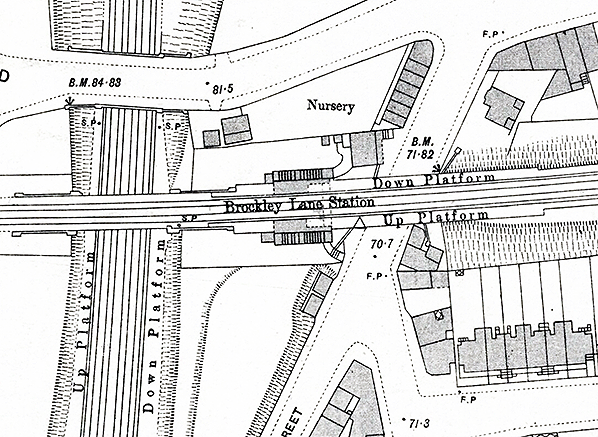
1895 1.1,065 map clearly shows the layout of the station. The booking office is up a flight of two steps from Brockley Cross. At the back of the booking office there is an open walkway leading to a co vered stairway to the up platform and a subway leading to a covered stairway to the down patform. At the top of the two covered stairways there is a shprt canopy for weather protection and and waiting rooms were provided on both platforms, with an office for the station master on the down side.
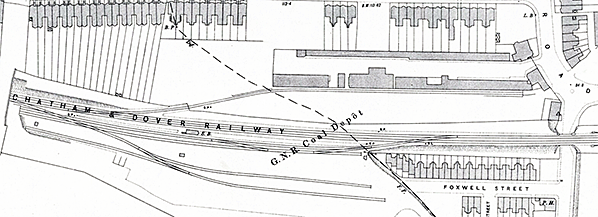
1895 1.1,065 map shows the GNR coal depot to the west of Brockley Lane station. Martin's siding is seen on the up side. Click here for a larger version
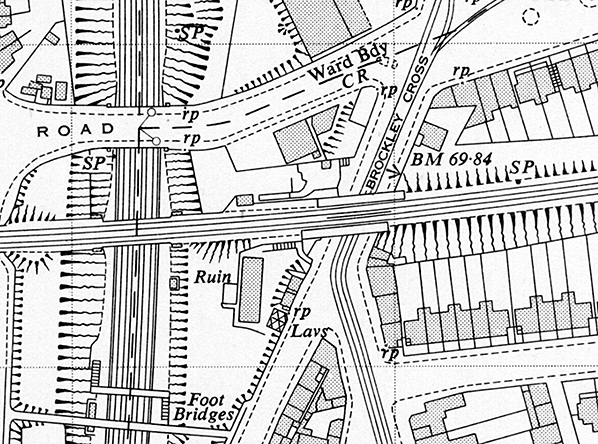
1951 1:2,500 OS map. The platfrorm remnants on the bridge over Brockley Cross are clearly shown, as is the surviving building that stood at the back of the west end of
the up platform. 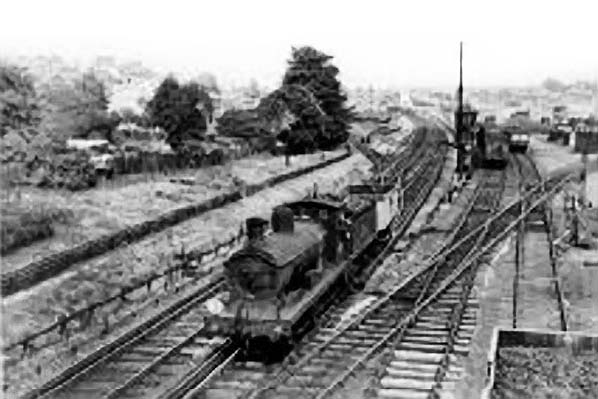 A goods train is heading west and passing the GNR coal depot at Brockley Lane in the first decade of the 20th century. The track layout seen here clearly matches the 1895 map above.
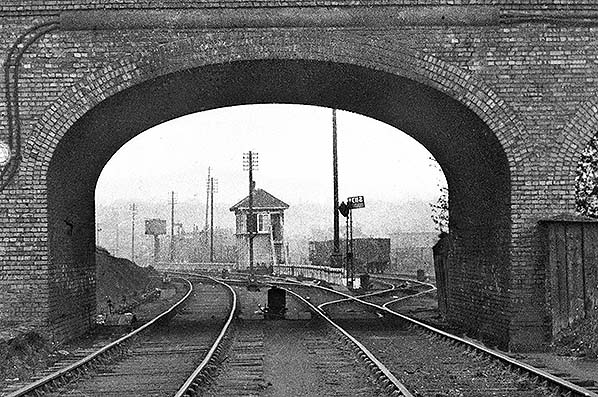 Looking east at the Brockley Lane coal depot. The Avignon Road bridge is in the foreground. Looking east at the Brockley Lane coal depot. The Avignon Road bridge is in the foreground.Photo from Duncan Chandler collection from his Flickr photostream 5.jpg)
Brockley Lane station looking west c.early 1920s. a few years after the station closed.
Photo from John Mann collection 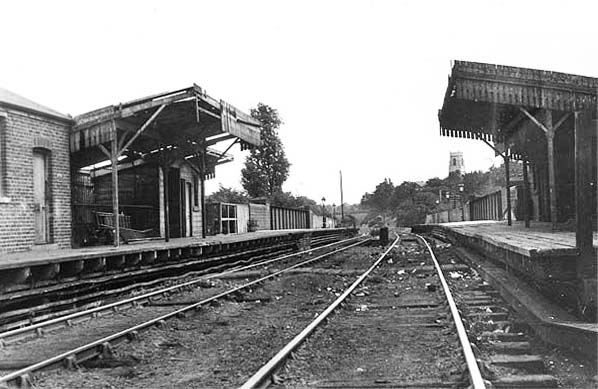
Brockley Lane station looking east c.early 1920s. The platforms are of timber apart from the section on the bridge over Brockley Cross.
Photo from John Mann collection 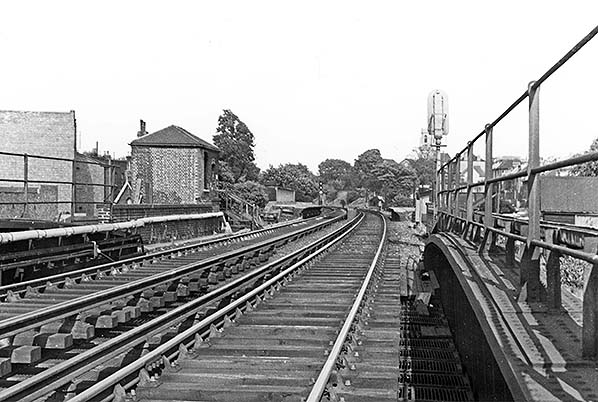
Brockley Lane station looking east c.early 1950s. The platforms have been largely demolished leaving only the platform remnants on the bridge over Brockley Cross. Although the platforms have gone the small brick building which once stood at the back of the up platform survives. It has now been provided with steps down to track level. Its purpose is unknown.
Photo from John Mann collection. lane25.jpg)
Brockley Lane coal depot in 1971 seen from Avignon Road bridge.
Photo
by Tom Burnham from his Flickr photostream
8.jpg)
Brockley Lane station in February 1982. The platforms were built largely of timber but the short section of platform above Brockley Cross was build of brick and this survived into the 1980s.
Photo by Nick Catford 1.jpg)
Brockley Lane station looking east from the down platform in February 1982. The platforms were built largely of timber but the short section of platform above Brockley Cross was build of brick and this survived into the 1980s.
Photo by Nick Catford Click here Brockley Lane Station Gallery 2: February 1982 - June 2006  Home Page Home Page
|
 Notes: Brockley Lane Station had a street level entrance on the west side of Brockley Road on the down side of the line. From the entrance a path led to a subway under the line with stairs up to the two platforms. The platforms were largely constructed of wood apart from short sections on the bridge over Brockley Road, which were brick. The track level buildings were also of timber construction and stood at the London end of the station. Waiting rooms were provided on both platforms, with an office for the Stationmaster on the down side.
Notes: Brockley Lane Station had a street level entrance on the west side of Brockley Road on the down side of the line. From the entrance a path led to a subway under the line with stairs up to the two platforms. The platforms were largely constructed of wood apart from short sections on the bridge over Brockley Road, which were brick. The track level buildings were also of timber construction and stood at the London end of the station. Waiting rooms were provided on both platforms, with an office for the Stationmaster on the down side.
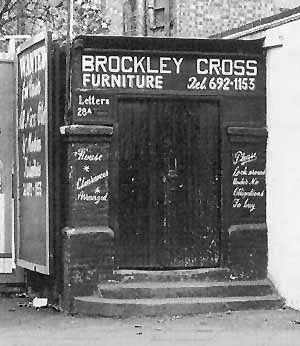
 The original plans for the Greenwich Park branch proposed a line from Nunhead through Greenwich terminating at the Royal Dockyard in Woolwich. With the opening of the South Eastern Railways extension from Greenwich to Woolwich in 1849 there was no longer a need to serve Woolwich and the London Chatham & Dover Railway were eventually authorised t o build a 2m18ch line between Nunhead and Crooms Hill, on the western side of Greenwich Park by an Act of Parliament in July 1863.
The original plans for the Greenwich Park branch proposed a line from Nunhead through Greenwich terminating at the Royal Dockyard in Woolwich. With the opening of the South Eastern Railways extension from Greenwich to Woolwich in 1849 there was no longer a need to serve Woolwich and the London Chatham & Dover Railway were eventually authorised t o build a 2m18ch line between Nunhead and Crooms Hill, on the western side of Greenwich Park by an Act of Parliament in July 1863.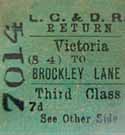 Despite disappointing receipts, the LCDR continued with their proposal to extend to Greenwich. The original powers had lapsed and a new Act was required which was received in 1881. The company was still in financial difficulty and the extension wasn’t completed to Greenwich Park (Greenwich until 1900) until 1st October 1888. A substantial terminus was built in Stockwell Street and not Crooms Hill as originally planned because housing development had overtaken the railway.
Despite disappointing receipts, the LCDR continued with their proposal to extend to Greenwich. The original powers had lapsed and a new Act was required which was received in 1881. The company was still in financial difficulty and the extension wasn’t completed to Greenwich Park (Greenwich until 1900) until 1st October 1888. A substantial terminus was built in Stockwell Street and not Crooms Hill as originally planned because housing development had overtaken the railway. With the amalgamation of the LCDR and SER in 1899, Greenwich was renamed Greenwich Park to avoid confusion and with the introduction of electric trams from 1908 it was soon clear that the line could never make a profit. A push-pull service was introduced in 1913 in an attempt to cut losses and by the start of WW1, a 20 minute peak hour service and 45 minute off peak service was being maintained. Both the Greenwich Park and Crystal Palace branches were closed on 1st January 1917 as a war time economy measure; the Crystal Palace service was reinstated in 1919 but the Greenwich Park branch never reopened.
With the amalgamation of the LCDR and SER in 1899, Greenwich was renamed Greenwich Park to avoid confusion and with the introduction of electric trams from 1908 it was soon clear that the line could never make a profit. A push-pull service was introduced in 1913 in an attempt to cut losses and by the start of WW1, a 20 minute peak hour service and 45 minute off peak service was being maintained. Both the Greenwich Park and Crystal Palace branches were closed on 1st January 1917 as a war time economy measure; the Crystal Palace service was reinstated in 1919 but the Greenwich Park branch never reopened.
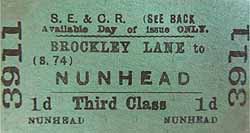 In 1927 Southern Railway refurbished the section of line between Nunhead and Lewisham Road as part of a scheme to improve freight operations in the locality; this involved building a spur down to join the Mid Kent line between St. Johns and Lewisham, at the same time the track was reballasted and relaid reopening on 7.7. 1929. The remaining severed section of the branch between Lewisham Road and Greenwich Park was formerly abandoned by Act of Parliament in 1929.The new loop line number of freight services in the area and it was electrified in 1935.
In 1927 Southern Railway refurbished the section of line between Nunhead and Lewisham Road as part of a scheme to improve freight operations in the locality; this involved building a spur down to join the Mid Kent line between St. Johns and Lewisham, at the same time the track was reballasted and relaid reopening on 7.7. 1929. The remaining severed section of the branch between Lewisham Road and Greenwich Park was formerly abandoned by Act of Parliament in 1929.The new loop line number of freight services in the area and it was electrified in 1935.